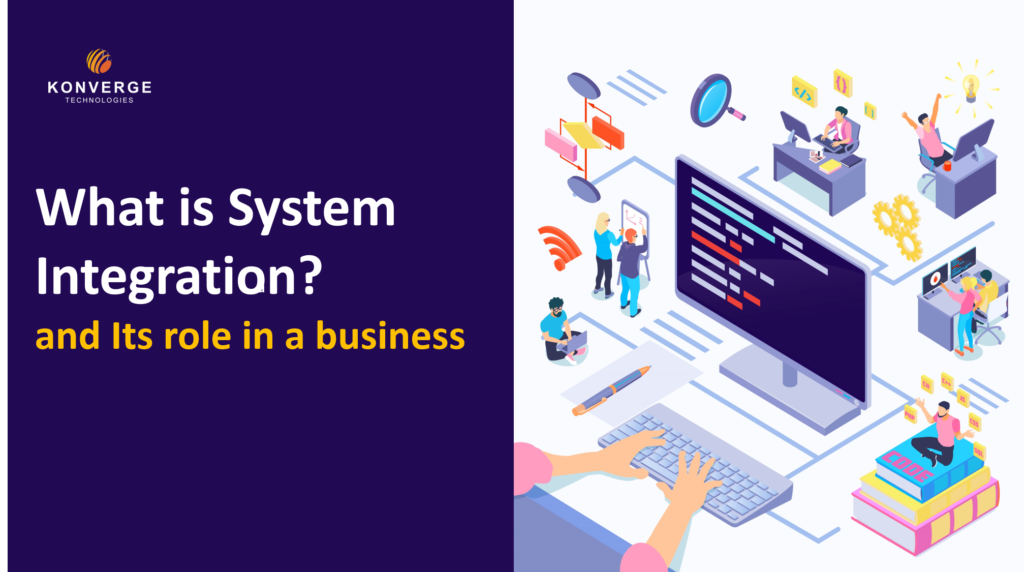
Businesses face technical issues — comprising software challenges, hardware challenges, or both—every now and then. Therefore it is advisable to keep a system handy for troubleshooting. This is where the system integration jumps in—which enables improved productivity and quality of operations.
Following are the pointers that we will cover in today’s blog.
- What is system integration?
- IT System Integrators and examples.
- Methods of System Integration
- What is the importance of system integration?
Contents
What is System Integration?
It is a general and often considered the ‘best’ practice to choose the best from the software lot; however, these frameworks often fail to communicate with each other. In other words, this means that any business data remains dispersed across software rather than staying in one place. System Integration unites the component subsystem into one functional system; every component works in harmony, thus preserving operational efficiency and finding out accurate data analysis. The data shared may include client information and queries, orders, production line information, and many more.
Broadly, System Integration is divided into three types based on utilization.
- Enterprise Application Integration (EAI)
- Data Integration (DI)
- Electronic Document Integration/Interchange (EDI)
What are SIs or System Integrators?
In the IT world, a firm or an individual specializing in transforming clients’ disparate hardware and software subsystems into a comprehensive IT solution. This approach streamlines a technology environment, allowing them to move towards business goals quickly. A few examples are Deloitte, Accenture, IBM, and more. These firms deliver large IT projects like ERP Project Management.
Before choosing an automation system integrator, the initial step in the integration process is to evaluate business needs and determine the prerequisites for their transformation. The next step involves the development and execution of the integration plans. Followed by efforts for testing and improving the system, at times, system integrators offer IT maintenance at times.
Methods of System Integration
Deciding on a fitting system integration solution is a complicated task. One has to select the appropriate subsystems, the correct locations, and the right idea of relationships. For this, it is vital that businesses fully understand the nature of processes involved to enable system integration to run smoothly. Following are system integration methods in brief.
- Point-to-point Integration: Ideal for a 1:1 relationship, this system integration can handle one business process at a time. 1:1 relationship implies the process is running between one system to another.
- Vertical Integration: Typically, each subsystem is connected to the next based on its functional proximity. This prompts a ‘warehouse ‘-like structure with the base being the most fundamental in capacity and the rest getting more advanced in nature.
- Star Integration: Star integration is a simple assortment of point-to-point system integrations. Another way of saying it is, this integration brings an extensive set of simple connections, typically in star format. The number of subsystems is directly proportional to the start points, which either increases or downsizes the number of lines in between.
- Horizontal Integration: It refers to accomplishing system integration utilizing one particular subsystem as a standard UI layer, which connects all the other subsystems. It means the number of connections essential for system integration is minimized as the subsystems are not linked directly.
Importance of the System Integration
As mentioned, system integration facilitates communication between systems that fail to communicate. It enhances the speed of data flow and downsizes the operational cost. There are several benefits for implementing system integration in businesses, few of the most important ones are discussed under:
- Automatic Integration: Before SIs existed, it was a common practice to enter the same information into multiple systems. It made the data flow a slow process. The system integration enabled a quick flow of information, making critical information available throughout the organization.
- Seamless Communication: It is usual for data to become inconsistent between systems, especially if they are not coordinated. For instance, one framework might be refreshed with a client’s new location, yet another one may not get the update. Integrating these frameworks cut down the chances of any confusion by updating information everywhere, all at once.
- Hasslefree and Budget-friendly: Integrated systems permit businesses to use their investment in them. Rather than substituting multiple existing frameworks with a single, extensive, costly new framework, businesses can integrate the whole existing frameworks at a comparatively lower cost. It also saves the hassle of going through the complicated implementation process.
- Brings new insights: It is normal to set up a business intelligence (BI) framework as a system integration component. This can be just about as straightforward as an Excel spreadsheet or something more refined like Microsoft Business Intelligence. The BI framework can total information from different frameworks to offer a general perspective on your business. This can provide an experience that would have been missed, accordingly making your business more competitive.
- Enhances Sales: Seamless data connectivity across departments encourages customers to purchase goods or services. Additionally, system integration solutions offer customers the data they need the most, making the purchasing experience much easier and more meaningful. This implies that customers can visibly see if the desired product is available, the time span it will remain open, and the time it will require to reach them.
Transparency is a powerful tool apparatus with regards to a customer wishing to buy a business service or product, making system integration an instrumental tool for any online sales process.
[“source=konverge”]


